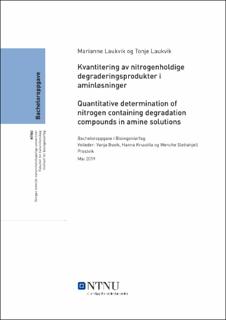| dc.contributor.advisor | Buvik, Vanja | |
| dc.contributor.advisor | Knuutila, Hanna | |
| dc.contributor.advisor | Prestvik, Wenche S. | |
| dc.contributor.author | Laukvik, Marianne | |
| dc.contributor.author | Laukvik, Tonje | |
| dc.date.accessioned | 2019-08-25T14:06:22Z | |
| dc.date.issued | 2019 | |
| dc.identifier | no.ntnu:inspera:43439669:43691420 | |
| dc.identifier.uri | http://hdl.handle.net/11250/2610812 | |
| dc.description.abstract | I lys av økt mengde klimagasser i atmosfæren, har CO2-fangst blitt et stadig viktigere satsningsområde. Store mengder CO2 emitteres ut i atmosfæren som følge av intensivert forbrenning av fossilt brennstoff. Behovet for teknologi som kan redusere CO2-utstlipp, som fører til globale klimaforandringer, er derfor nødvendig. CO2-fangst og -lagring med aminbaserte løsninger (CCS) er en teknologi som bidrar til å redusere mengden CO2 som blir frigjort ved forbrenning av fossil energi eller industriell produksjon av sement og stål.
En utfordring med karbonfangst med aminer, er at aminene har en tendens til å degradere over tid. I denne oppgaven ble det opprettet og validert en metode for å detektere total nitrogen (TN)-konsentrasjon i ulike degraderte aminløsninger. Presisjon og riktighet ble vurdert, og deteksjons- og kvantiteringsgrense ble fastsatt. Resultat fra analysering av aminløsninger på Shimadzu TOC-L ble sammenlignet med eksisterende data fra titreringsmetode som kvantiterer amintap, i oksidativt degraderte aminløsninger, over en periode på 21 dager med oksidativ degradering.
TN-deteksjonsmetode på Shimadzu TOC-L ble kalibrert med samme amin som skulle analyseres, for å kunne kvantitere degraderingsprodukter, deriblant varmestabile salter.
Ved sammenligning av analyseresultater fra Shimadzu TOC-L og amintap målt ved titrering, fremgår det at de fleste av de analyserte aminer degraderer i større eller mindre grad. Degraderingsprodukter for MEA-, TEA-, MMEA-, DMMEA-, DGA-, AP- og DEEA-prøver ble kvantitert med TN-deteksjonsmetode på Shimadzu TOC-L.
Analysemetoden viser seg å fungere til dens tiltenkte formål. For MEA, ble det kvantitert en økning på 32 % i konsentrasjon av ikke-basiske, nitrogenholdige komponenter (degraderingsprodukter), etter 21 dager. I konsentrasjonsområdet 100 ppm N, som aminprøvene ble fortynnet til, kan analyseresultatene for MEA-prøver angis med en usikkerhet på 4%. For TEA ble det kvantitert 6% degraderingsprodukter, med en usikkerhet på 4% i samme konsentrasjonsområde. Degraderingsprodukter for DEEA ble kvantitert til 4% med en usikkerhet på 10%. Konsentrasjonen av degraderingsprodukter for MMEA ble kvantitert til 28%, med en usikkerhet på er 4%. For DMMEA ble det kvantitert 5% degraderingsprodukter med en usikkerhet på 1%. For DGA og AP ble det kvantitert degraderingsprodukt på henholdsvis 14% og 9%. Resultatene for DGA og AP kan angis med en usikkerhet på 5% og 4%. | |
| dc.description.abstract | In view of rising amounts of greenhouse gases in the atmosphere, carbon capture is an increasingly important focus area. Large amounts of carbon dioxide (CO2) are emitted into the atmosphere as a result of intensified combustion of fossil fuels. The need for technology that can reduce CO2 emissions leading to global climate change, is therefore necessary. Carbon capture and storage with amine-based solutions (CCS) is a technology that helps reduce the amount of CO2 released during the combustion of fossil energy or industrial production of materials like cement and steel.
An issue with the amine-based carbon capture method, is that the amines are prone to degrade over time. In this task, a method was established and validated to detect total nitrogen (TN) concentration in various degraded amine solutions. Precision and accuracy were assessed, and limit of detection (LOD) and limit of quantification (LOQ) were determined. Results from the analysis of amine solutions on Shimadzu TOC-L were compared to existing data from a titration method which quantifies loss of amines, in degraded amine solutions, over a period of 21 days of oxidative degradation.
The total nitrogen detection method on Shimadzu TOC-L was performed by calibration with the same amine to be analyzed, to quantify degradation products, including heat-stable salts. When comparing the analysis results of Shimadzu TOC-L and loss of amines measured by titration, it appears that most of the analyzed amines degrade in greater or lesser extent. Degradation products for MEA, TEA, MMEA, DMMEA, DGA, AP and DEEA samples were quantitated with TN detection method on Shimadzu TOC-L.
The analysis method turns out to work for its intended purpose. For MEA, the increase in concentration of nitrogen found in non-alkaline compounds (degradation products) was 32% after 21 days of oxidative degradation. In the concentration range 100 ppm N, the analysis results for MEA samples can be stated with an uncertainty of 4%. For TEA, 6% degradation products were quantified, with an uncertainty of 4% in the same concentration range. DEEA degradation products were quantified to 4% with a 10% uncertainty. The concentration of degradation product for MMEA was 28%, with an uncertainty of 4%. For DMMEA, 5% degradation product was quantified with 1% uncertainty. For DGA and AP, degradation product of 14% and 9%, respectively, was quantified. The results for DGA and AP can be stated with an uncertainty of 5% and 4%. | |
| dc.language | nob | |
| dc.publisher | NTNU | |
| dc.title | Kvantitering av nitrogenholdige degraderingsprodukter i aminløsninger | |
| dc.type | Bachelor thesis | |
